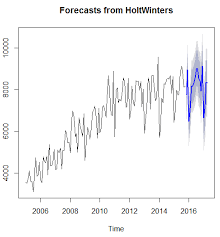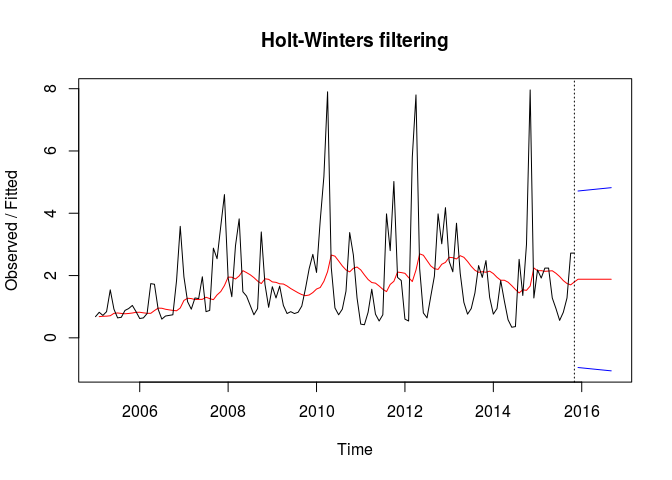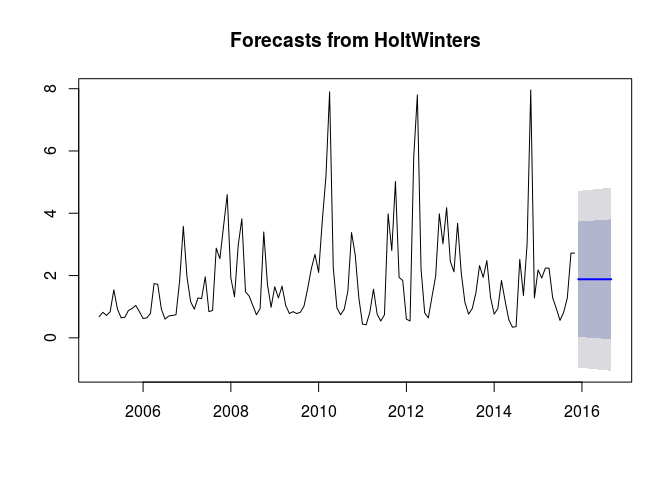Hi, I need some assistance in forecasting which am trying to learn in R. I have a data frame for 10 years where I would like to have a forecast for the next five years. I would like to produce a graph like the one below:

This is my script am trying to work on:
library(tidyverse)
library(lubridate)
library(ggplot2)
library(forecast)
river <- data.frame(stringsAsFactors = FALSE,
flow = c(3.4, 4.1, 3.6, 4.2, 7.7, 4.6, 3.2, 3.3, 4.4,
4.7, 5.2, 4.2, 3.1, 3.2, 3.9, 8.7, 8.6, 4.6,
3, 3.5, 3.6, 3.7, 9.2, 17.9, 9.8, 5.8, 4.6, 6.4,
6.3, 9.8, 4.2, 4.4, 14.4, 12.7, 17.9, 23, 9.6, 6.6,
14.8, 19.1, 7.4, 6.7, 5.2, 3.7, 4.7, 17, 8.6,
4.9, 8.2, 6.4, 8.3, 5.2, 3.9, 4.2, 3.9, 4.1, 5.1,
7.9, 11.1, 13.4, 10.5, 18.8, 25.9, 39.5, 11.3, 4.8, 3.7,
4.6, 7.5, 16.9, 13.3, 6.4, 2.2, 2.1, 4.1, 7.8, 3.8,
2.7, 3.7, 19.9, 14, 25.1, 9.7, 9.2, 3, 2.7, 29, 39,
11.1, 4, 3.2, 6.6, 9.9, 19.9, 15.1, 20.9, 12.3, 10.6,
18.4, 10.4, 5.7,3.8, 4.7, 7.2, 11.6, 9.7, 12.4, 6.5,
3.8, 4.7, 9.2, 5.9, 2.9, 1.7, 1.8, 12.6, 6.8, 15,
39.8, 6.4, 10.9, 9.6, 11.2, 11.2, 6.4, 4.7, 2.8,
4.1, 6.4, 13.6, 13.6),
time = c("Jan-05", "Feb-05", "Mar-05", "Apr-05", "May-05", "Jun-05",
"Jul-05", "Aug-05", "Sep-05", "Oct-05", "Nov-05", "Dec-05",
"Jan-06", "Feb-06", "Mar-06", "Apr-06", "May-06", "Jun-06",
"Jul-06", "Aug-06", "Sep-06", "Oct-06", "Nov-06", "Dec-06",
"Jan-07", "Feb-07", "Mar-07", "Apr-07", "May-07", "Jun-07",
"Jul-07", "Aug-07", "Sep-07", "Oct-07", "Nov-07", "Dec-07",
"Jan-08", "Feb-08", "Mar-08", "Apr-08", "May-08", "Jun-08",
"Jul-08", "Aug-08", "Sep-08", "Oct-08", "Nov-08", "Dec-08",
"Jan-09", "Feb-09", "Mar-09", "Apr-09", "May-09", "Jun-09",
"Jul-09", "Aug-09", "Sep-09", "Oct-09", "Nov-09", "Dec-09",
"Jan-10", "Feb-10", "Mar-10", "Apr-10", "May-10", "Jun-10",
"Jul-10", "Aug-10", "Sep-10", "Oct-10", "Nov-10", "Dec-10",
"Jan-11", "Feb-11", "Mar-11", "Apr-11", "May-11", "Jun-11",
"Jul-11", "Aug-11", "Sep-11", "Oct-11", "Nov-11", "Dec-11",
"Jan-12", "Feb-12", "Mar-12", "Apr-12", "May-12", "Jun-12",
"Jul-12", "Aug-12", "Sep-12", "Oct-12", "Nov-12", "Dec-12",
"Jan-13", "Feb-13", "Mar-13", "Apr-13", "May-13", "Jun-13",
"Jul-13", "Aug-13", "Sep-13", "Oct-13", "Nov-13", "Dec-13",
"Jan-14", "Feb-14", "Mar-14", "Apr-14", "May-14", "Jun-14",
"Jul-14", "Aug-14", "Sep-14", "Oct-14", "Nov-14", "Dec-14",
"Jan-15", "Feb-15", "Mar-15", "Apr-15", "May-15", "Jun-15",
"Jul-15", "Aug-15", "Sep-15", "Oct-15", "Nov-15", "Dec-15"))
river %>%
mutate(time = dmy(paste("01-", time)), flow = flow / 5) %>%
gather(variable, flow, -time) %>%
df<-ts(river, start=c(2005))
df<-forecast.HoltWinters(df,beta=F, gamma=F,h=10)

